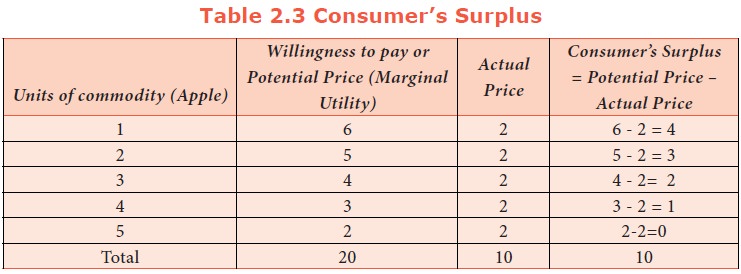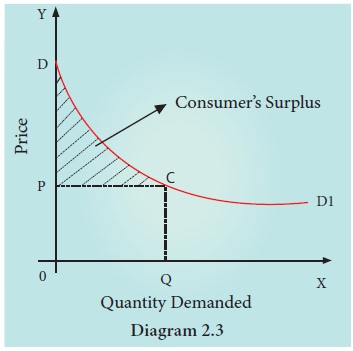Economics - Consumer's Surplus | 11th Economics : Chapter 2 : Consumption Analysis
Chapter: 11th Economics : Chapter 2 : Consumption Analysis
Consumer's Surplus
Consumer's
Surplus
The
concept of consumer surplus was originally introduced by classical economists
and later modified by Jevons and Jule Dupuit, the French Engineer Economist in
1844. But a most refined form of the concept of consumer surplus was given by
Alfred Marshall. This concept is based on the Law of Diminishing Marginal
Utility.
Definition
Alfred
Marshall defines consumer’s surplus as, “the excess of price which a person
would be willing to pay a thing rather than go without the thing, over that
which he actually does pay is the economic measure of this surplus
satisfaction. This may be called consumer’s surplus”.
Assumptions
1.
Marshall assumed that utility can be measured.
2.
The marginal utilities of money of the consumer
remain constant.
3.
There are no substitutes for the commodity in
question.
4.
The taste, income and character of the consumer do
not change.
5.
Utility of one commodity does not depend upon the
other commodities.
Explanation
The
concept of consumer’s surplus can be explained with help of an example. Suppose
a consumer wants to buy an apple. He is willing to pay Rs.4, rather than go without it and the actual
price of the apple is Rs.2. Hence the
consumer’s surplus is Rs.2( Rs.4- Rs.2).
Thus, consumer’s surplus is the difference between the price that a consumer is
willing to pay (potential price) and what he actually pays. Therefore,
Consumer’s surplus = What a person is willing to pay – What he actually pays.
OR
Consumer’s surplus = Potential price – Actual price.
Mathematically
Consumer’s
surplus = TU – (P x Q)
where,
TU =
Total Utility, P = Price and Q= Quantity of the commodity
The
measurement of consumer’s surplus is illustrated in Table 2.3.

In Table
2.3 the consumer is willing to pay rupees 6, 5, 4, 3 and 2 for purchasing the
successive units of apples. Hence, he is willing to pay (Potential Price Total
Utility) Rs.20 for apples. But, he
actually pays Rs.10 ( Rs.2 x 5)) for
getting 5 apples. Hence,
Consumer’s Surplus = Total Utility (Actual Price x units of Commodity)
= TU – (P x Q)
= –(2 x
5)
= 20-10 =
10.
The
concept of Consumer’s Surplus can also be explained with the help of a diagram.

In the
diagram 2.3, X axis shows the amount demanded and Y axis represents the price.
DD1 shows the utility which the consumer derives from the purchase of different
amounts of commodity. When price is OP, the amount demanded is OQ.
Hence,
actual price is OPCQ (OP x OQ).
Potential
Price (Total Utility) is ODCQ.
Therefore,
Consumer’
Surplus = ODCQ – OPCQ = PDC (the shaded area)
Criticism
1.
Utility cannot be measured, because utility is
subjective.
2.
Marginal utility of money does not remain constant.
3.
Potential price is internal, it might be known to
the consumer himself.
Related Topics